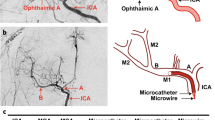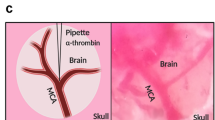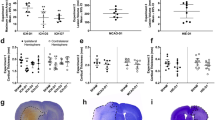Abstract
The development of controllable and reproducible animal models of intracerebral hemorrhage (ICH) is essential for the systematic study of the pathophysiology and treatment of hemorrhagic stroke. In recent years, we have used a modified version of a murine ICH model to inject blood into mouse basal ganglia. According to our protocol, autologous blood is stereotactically infused in two stages into the right striatum to mimic the natural events of hemorrhagic stroke. Following ICH induction, animals demonstrate reproducible hematomas, brain edema formation and marked neurological deficits. Our technique has proven to be a reliable and reproducible means of creating ICH in mice in a number of acute and chronic studies. We believe that our model will serve as an ideal paradigm for investigating the complex pathophysiology of hemorrhagic stroke. The protocol for establishing this model takes about 2 h.
This is a preview of subscription content, access via your institution
Access options
Subscribe to this journal
Receive 12 print issues and online access
$259.00 per year
only $21.58 per issue
Buy this article
- Purchase on Springer Link
- Instant access to full article PDF
Prices may be subject to local taxes which are calculated during checkout





Similar content being viewed by others
References
Broderick, J.P. et al. Guidelines for the management of spontaneous intracerebral hemorrhage: a statement for healthcare professionals from a special writing group of the Stroke Council, American Heart Association. Stroke 30, 905–915 (1999).
Dennis, M.S. et al. Long-term survival after first-ever stroke: the Oxfordshire Community Stroke Project. Stroke 24, 796–800 (1993).
Anderson, C.S., Chakera, T.M., Stewart-Wynne, E.G. & Jamrozik, K.D. Spectrum of primary intracerebral haemorrhage in Perth, Western Australia, 1989–90: incidence and outcome. J. Neurol. Neurosurg. Psychiatry 57, 936–940 (1994).
Gong, C., Hoff, J.T. & Keep, R.F. Acute inflammatory reaction following experimental intracerebral hemorrhage in rat. Brain Res. 871, 57–65 (2000).
Hua, Y., Xi, G., Keep, R.F. & Hoff, J.T. Complement activation in the brain after experimental intracerebral hemorrhage. J. Neurosurg. 92, 1016–1022 (2000).
Wagner, K.R., Sharp, F.R., Ardizzone, T.D., Lu, A. & Clark, J.F. Heme and iron metabolism: role in cerebral hemorrhage. J. Cereb. Blood Flow Metab. 23, 629–652 (2003).
Wang, J., Rogove, A.D., Tsirka, A.E. & Tsirka, S.E. Protective role of tuftsin fragment 1–3 in an animal model of intracerebral hemorrhage. Ann. Neurol. 54, 655–664 (2003).
Xi, G. et al. Intracerebral hemorrhage: pathophysiology and therapy. Neurocrit. Care 1, 5–18 (2004).
Andaluz, N., Zuccarello, M. & Wagner, K.R. Experimental animal models of intracerebral hemorrhage. Neurosurg. Clin. N. Am. 13, 385–393 (2002).
Kaufman, H. & Schochet, S. Pathology, pathophysiology, and modeling. in Intracerebral Hematomas: Etiology, Pathophysiology, Clinical Presentation, and Treatment (ed. Kaufman, H.) 13–20 (Raven Press, New York, 1992).
Mun-Bryce, S., Wilkerson, A.C., Papuashvili, N. & Okada, Y.C. Recurring episodes of spreading depression are spontaneously elicited by an intracerebral hemorrhage in the swine. Brain Res. 888, 248–255 (2001).
Del Bigio, M.R., Yan, H.J., Campbell, T.M. & Peeling, J. Effect of fucoidan treatment on collagenase-induced intracerebral hemorrhage in rats. Neurol. Res. 21, 415–419 (1999).
Enzmann, D.R., Britt, R.H., Lyons, B.E., Buxton, J.L. & Wilson, D.A. Natural history of experimental intracerebral hemorrhage: sonography, computed tomography and neuropathology. AJNR Am. J. Neuroradiol. 2, 517–526 (1981).
Rosenberg, G.A., Estrada, E., Kelley, R.O. & Kornfeld, M. Bacterial collagenase disrupts extracellular matrix and opens blood–brain barrier in rat. Neurosci. Lett. 160, 117–119 (1993).
Rosenberg, G.A., Mun-Bryce, S., Wesley, M. & Kornfeld, M. Collagenase-induced intracerebral hemorrhage in rats. Stroke 21, 801–807 (1990).
Choudhri, T.F., Hoh, B.L., Solomon, R.A., Connolly, E.S. Jr. & Pinsky, D.J. Use of a spectrophotometric hemoglobin assay to objectively quantify intracerebral hemorrhage in mice. Stroke 28, 2296–2302 (1997).
Lyden, P.D., Jackson-Friedman, C. & Lonzo-Doktor, L. Medical therapy for intracerebral hematoma with the gamma-aminobutyric acid-A agonist muscimol. Stroke 28, 387–391 (1997).
Del Bigio, M.R., Yan, H.J., Buist, R. & Peeling, J. Experimental intracerebral hemorrhage in rats. Magnetic resonance imaging and histopathological correlates. Stroke 27, 2312–2319; discussion 2319–2320 (1996).
Xue, M. & Del Bigio, M.R. Intracerebral injection of autologous whole blood in rats: time course of inflammation and cell death. Neurosci. Lett. 283, 230–232 (2000).
Xue, M. & Del Bigio, M.R. Comparison of brain cell death and inflammatory reaction in three models of intracerebral hemorrhage in adult rats. J. Stroke Cerebrovasc. Dis. 12, 152–159 (2003).
Belayev, L. et al. Experimental intracerebral hemorrhage in the mouse: histological, behavioral, and hemodynamic characterization of a double-injection model. Stroke 34, 2221–2227 (2003).
Nakamura, T. et al. Intracerebral hemorrhage in mice: model characterization and application for genetically modified mice. J. Cereb. Blood Flow Metab. 24, 487–494 (2004).
Xi, G., Hua, Y., Keep, R.F., Younger, J.G. & Hoff, J.T. Systemic complement depletion diminishes perihematomal brain edema in rats. Stroke 32, 162–167 (2001).
Deinsberger, W., Vogel, J., Kuschinsky, W., Auer, L.M. & Boker, D.K. Experimental intracerebral hemorrhage: description of a double injection model in rats. Neurol. Res. 18, 475–477 (1996).
Yang, G.Y., Betz, A.L., Chenevert, T.L., Brunberg, J.A. & Hoff, J.T. Experimental intracerebral hemorrhage: relationship between brain edema, blood flow, and blood–brain barrier permeability in rats. J. Neurosurg. 81, 93–102 (1994).
Hickenbottom, S.L., Grotta, J.C., Strong, R., Denner, L.A. & Aronowski, J. Nuclear factor-kappaB and cell death after experimental intracerebral hemorrhage in rats. Stroke 30, 2472–2477, discussion 2477–2478 (1999).
Felberg, R.A. et al. Cell death in experimental intracerebral hemorrhage: the 'black hole' model of hemorrhagic damage. Ann. Neurol. 51, 517–524 (2002).
Rynkowski, M.A. et al. C3a-receptor antagonist attenuates brain injury from intracerebral hemorrhage in mice. Stroke 39(2) (2008, in the press).
Xi, G. et al. Role of blood clot formation on early edema development after experimental intracerebral hemorrhage. Stroke 29, 2580–2586 (1998).
Connolly, E.S. Jr., Winfree, C.J., Stern, D.M., Solomon, R.A. & Pinsky, D.J. Procedural and strain-related variables significantly affect outcome in a murine model of focal cerebral ischemia. Neurosurgery 38, 523–531, discussion 532 (1996).
Xi, G., Keep, R.F. & Hoff, J.T. Erythrocytes and delayed brain edema formation following intracerebral hemorrhage in rats. J. Neurosurg. 89, 991–996 (1998).
Tomita, H., Ito, U., Ohno, K. & Hirakawa, K. Chronological changes in brain edema induced by experimental intracerebral hematoma in cats. Acta Neurochir. Suppl. (Wien) 60, 558–560 (1994).
Bederson, J.B. et al. Rat middle cerebral artery occlusion: evaluation of the model and development of a neurologic examination. Stroke 17, 472–476 (1986).
Bouet, V. et al. Sensorimotor and cognitive deficits after transient middle cerebral artery occlusion in the mouse. Exp. Neurol. 203, 555–567 (2007).
Clark, W.M., Lessov, N.S., Dixon, M.P. & Eckenstein, F. Monofilament intraluminal middle cerebral artery occlusion in the mouse. Neurol. Res. 19, 641–648 (1997).
Hua, Y. et al. Behavioral tests after intracerebral hemorrhage in the rat. Stroke 33, 2478–2484 (2002).
De Ryck, M., Van Reempts, J., Borgers, M., Wauquier, A. & Janssen, P.A. Photochemical stroke model: flunarizine prevents sensorimotor deficits after neocortical infarcts in rats. Stroke 20, 1383–1390 (1989).
Schallert, T., Fleming, S.M., Leasure, J.L., Tillerson, J.L. & Bland, S.T. CNS plasticity and assessment of forelimb sensorimotor outcome in unilateral rat models of stroke, cortical ablation, parkinsonism and spinal cord injury. Neuropharmacology 39, 777–787 (2000).
Li, X. et al. Chronic behavioral testing after focal ischemia in the mouse: functional recovery and the effects of gender. Exp. Neurol. 187, 94–104 (2004).
Yu, G.L. et al. Montelukast, a cysteinyl leukotriene receptor-1 antagonist, dose- and time-dependently protects against focal cerebral ischemia in mice. Pharmacology 73, 31–40 (2005).
Zhang, L. et al. A test for detecting long-term sensorimotor dysfunction in the mouse after focal cerebral ischemia. J. Neurosci. Methods 117, 207–214 (2002).
Paxinos, G. & Franklin, K.B.J. The Mouse Brain In Stereotaxic Coordinates (Elsevier Academic Press, Amsterdam and Boston, 2004).
Wahlsten, D., Hudspeth, W.J. & Bernhardt, K. Implications of genetic variation in mouse brain structure for electrode placement by stereotaxic surgery. J. Comp. Neurol. 162, 519–531 (1975).
Acknowledgements
Dr. M.A.R. was supported by The Kosciuszko Foundation Postdoctoral Research Fellowship.
Author information
Authors and Affiliations
Corresponding author
Rights and permissions
About this article
Cite this article
Rynkowski, M., Kim, G., Komotar, R. et al. A mouse model of intracerebral hemorrhage using autologous blood infusion. Nat Protoc 3, 122–128 (2008). https://doi.org/10.1038/nprot.2007.513
Published:
Issue Date:
DOI: https://doi.org/10.1038/nprot.2007.513
This article is cited by
-
LncRNA-SNHG3 promotes neuroinflammation post-intracerebral hemorrhage by regulating the miR-106b-5p/TXNIP axis
Molecular & Cellular Toxicology (2023)
-
Met-RANTES preserves the blood–brain barrier through inhibiting CCR1/SRC/Rac1 pathway after intracerebral hemorrhage in mice
Fluids and Barriers of the CNS (2022)
-
Mechanisms of neuroinflammation in hydrocephalus after intraventricular hemorrhage: a review
Fluids and Barriers of the CNS (2022)
-
Aprepitant attenuates NLRC4-dependent neuronal pyroptosis via NK1R/PKCδ pathway in a mouse model of intracerebral hemorrhage
Journal of Neuroinflammation (2022)
-
ER Stress is Involved in Mast Cells Degranulation via IRE1α/miR-125/Lyn Pathway in an Experimental Intracerebral Hemorrhage Mouse Model
Neurochemical Research (2022)
Comments
By submitting a comment you agree to abide by our Terms and Community Guidelines. If you find something abusive or that does not comply with our terms or guidelines please flag it as inappropriate.



